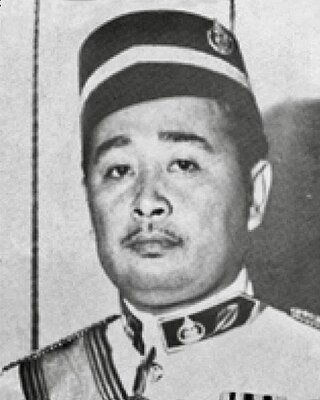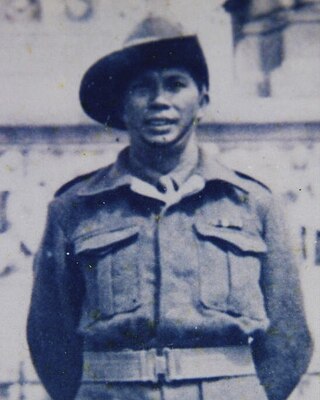Omar Ali Saifuddin I ibni Muhammad Alauddin, also known as Al-Marhum Makam Besar, was the 18th Sultan of Brunei and the second son of Sultan Muhammad Alauddin. He was regarded as one of the longest-serving sultans and was renowned for his wise leadership and just rule, merely following his father-in-law, Sultan Hussin Kamaluddin. In fact, he received helpful knowledge, counsel, and experience from his father-in-law when he was still alive during his reigning period.

Hashim Jalilul Alam Aqamaddin was the 25th Sultan of Brunei from 1885 to 1906.
Saiful Rijal ibni Abdul Kahar, also spelled Saiful Rehal and Saiful Rizal, was the eighth Sultan of Brunei and reigned from 1533 to 1581. He was succeeded by his eldest son Shah Berunai.
Sulaiman al-Qanuni ibni Sharif Ali, also known as Senior King and Adipati Agung, was the fifth Sultan of Brunei, according to Silsilah Raja-Raja Berunai. He succeeded his father in 1432 and ruled until his abdication in 1485, to allow his son Bolkiah to become Sultan.
Muhyiddin ibni Abdul Jalilul Akbar was the 14th Sultan of Brunei and the fourth son of Sultan Abdul Jalilul Akbar. He took the throne after defeating his opponent, Sultan Abdul Hakkul Mubin during the Brunei Civil War. Notably, he also attempted to return the throne back to the origin bloodline via Sultan Muhammad Ali's family.
Muhammad Hasan ibni Saiful Rijal Nurul Alam, also known as Marhum di Tanjung, was the tenth Sultan of Brunei from 1582 to 1598. Under him, the Bruneian Empire had apparently full control of the island of Borneo and Northern Philippines, including Sulu.
Muhammad Ali ibni Muhammad Hasan, also known as Marhum Tumbang Di Rumput, was the 12th Sultan of Brunei. His murder would later go on to spark the beginning of the Brunei Civil War between his killer and Sultan Muhyiddin, which a protracted civil war of succession that broke out and lasted for several years.
Abdul Hakkul Mubin ibni Muhammad Panjang, also known as Abdul Mubin or Al-Marhum di Pulau, was the 13th Sultan of Brunei. He was involved in the Brunei Civil War and ruled the sultanate from 1660 to 1673, after killing his uncle, Sultan Muhammad Ali.
Abdul Jalilul Akbar ibnu Muhammad Hasan, also known as Marhum Tua, was the eleventh Sultan of Brunei.

Sultan Omar Ali Saifuddien College, abbreviated as SOASC, is a government boys' secondary school in Bandar Seri Begawan, the capital of Brunei. It is the first secondary school in the country. The school is also one of the only three boys' secondary schools nationwide, with the other two being Muda Hashim Secondary School and Ma'had Islam Brunei. The school provides five years of secondary education leading up to GCE 'O' Level and IGCSE qualification.

Kampong Petani, also simply known as Petani, is a populated area in Tutong, the town of Tutong District, Brunei. It is officially a village-level subdivision under the mukim or subdistrict of Pekan Tutong, as well as a designated postcode area with the postcode TA1741. Parts of Petani area is also under the spatial jurisdiction of the municipality of Tutong. Petani is de facto the commercial area of the town.

The Istana Darussalam is the former residence of Omar Ali Saifuddien III and birthplace of Sultan of Brunei, Hassanal Bolkiah. The palace is located at Jalan Darussalam, Sumbiling Lama, Brunei-Muara District, Brunei. The building has become a tourist attraction and currently under the protection of the Antiquities and Treasure Trove Act of the Museums Department.

The Istana Kota Manggalela, also known as Istana Manggalela, is one of the temporary official residences of the then Sultan of Brunei, Omar Ali Saifuddien III. The palace is located at Jalan Maulana, Kuala Belait, Belait District, Brunei. The building has become a tourist attraction and historical site in the present day.

Berambang Island is an island at the southern bank of the Brunei River in the Mukim Kota Batu, Brunei-Muara District, Brunei. The island was formerly named Buang Tawer during The Brooke Era from 1841 until 1941. The mausoleum of the 9th Sultan of Brunei, Sultan Muhammad Hassan is located on the island, near Kampong Sungai Bunga.

Sufri Bolkiah ibni Omar Ali Saifuddien III is a member of the royal family of Brunei. He is the third son of Omar Ali Saifuddien III, the 28th Sultan of Brunei, and Raja Isteri (Queen) Pengiran Anak Damit. He is also the President of the Brunei Darussalam National Olympic Council (BDNOC) since 2010.

Zain bin Serudin, pen name Shukri Zain, is a Bruneian nobleman, politician and writer who formerly held the position of Minister of Religious Affairs from 1986 to 2010. He has traveled abroad and made significant literary contributions to Malay-Islamic literature, including Islamic poetry and usage of his own Malay language to convey his poetic ideas. He also was the leader or president of the Brunei Youth Council (BYL), and a member of the Privy Council.
Nasruddin ibni Besar Abdullah, sometimes spelled Nassaruddin and posthumously named Marhum di Kianggeh, was the self-proclaimed 15th Sultan of Brunei and the grandson of Sultan Abdul Jalilul Akbar. It was under his reign that the first gold coins or pitis were introduced, with the name Nasiruddin Malik al Zahir.
The Wazir are a group of royal dignitaries within the Sultanate of Brunei whose position ranks the second-highest official in the country behind the Sultan. The vizier had formerly held the position of the Sultan's highest official in the administration of the then-reigning government throughout Brunei's history, particularly during the times prior to and after the British protectorate. The core of Brunei's nobility consisted of this class of governmental offices, and it consists of a Perdana Wazir, and four Wazir under him, namely Bendahara, Di-Gadong, Pemancha and Temenggong. Notably, they are sometimes referred to as and acted as senior ministers.

Pengiran Abu Bakar MBE was a nobleman, civil servant, and politician who became the fifth Speaker of the Brunei legislative council, serving from 1 December 1974 until his retirement on 14 December 1981. Notably, he is the father-in-law to Princess Masna Bolkiah.

Pengiran Mohammad MBE or commonly referred to by his title Pengiran Temenggong and nicknamed National Hero, was a Bruneian nobleman, teacher and politician who formerly held several high-ranking positions which included being a member of the State Council, Privy Council, and the Islamic Religious Council. Notably, he is one of the founding members of the Royal Brunei Yacht Club and the Chairman of the Brunei Boxing Association.











